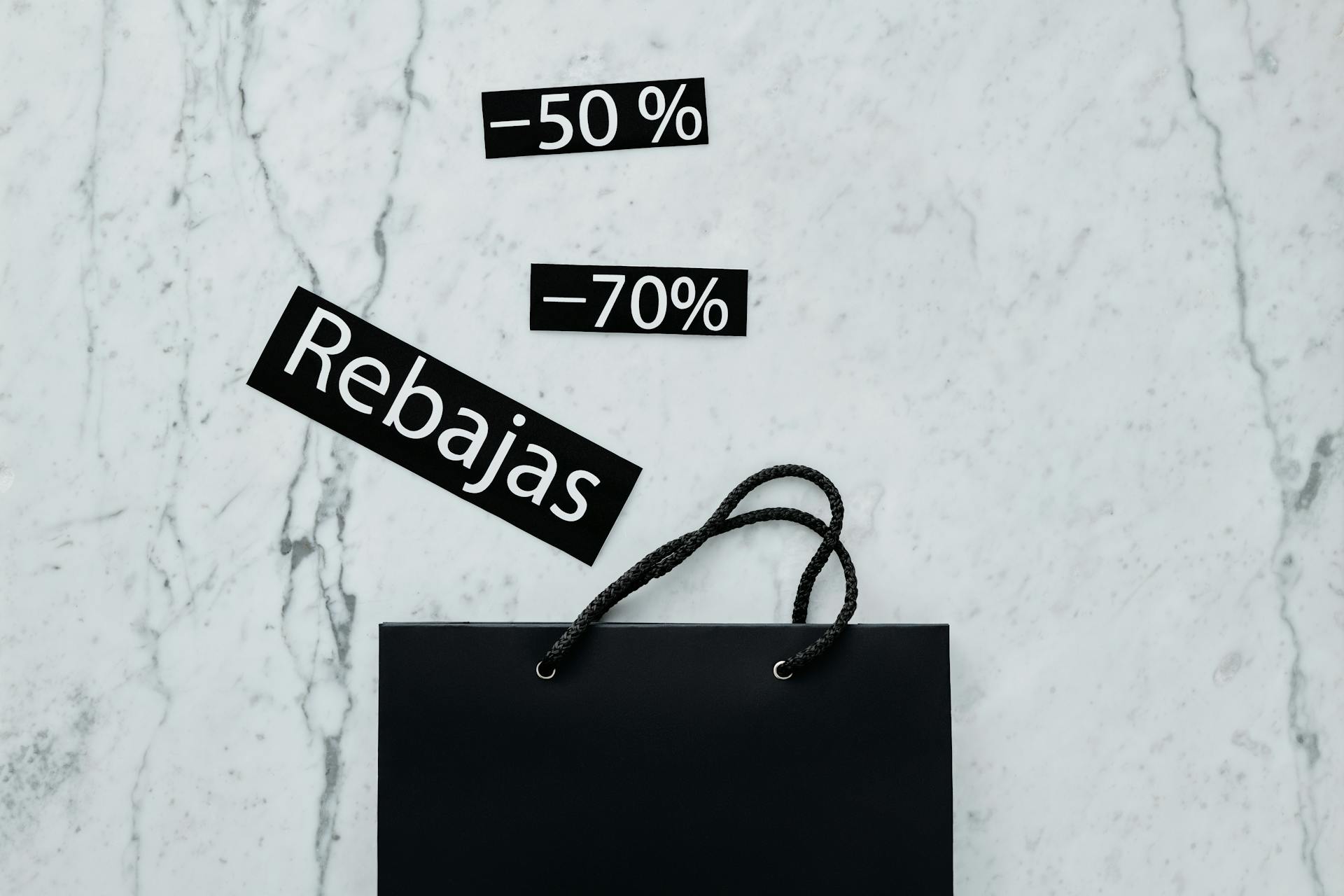
Invoice discounting can be a game-changer for businesses with outstanding invoices, providing access to much-needed capital.
This financing solution allows companies to sell their invoices to a third-party lender, who then pays the invoice amount upfront, minus a fee. The lender takes on the risk of the invoice not being paid by the customer.
Businesses can use this capital to cover operational costs, invest in growth initiatives, or simply free up cash flow. In fact, a survey found that 75% of businesses that used invoice discounting reported improved cash flow.
One of the key benefits of invoice discounting is that it can be more flexible than traditional bank loans, with fewer credit checks and less paperwork required.
Benefits and Advantages
Invoice discounting can be a game-changer for businesses struggling with cash flow issues. It provides fast access to working capital that would otherwise be tied up in unpaid invoices.
Companies can use invoice discounting to improve their cash flow, allowing them to pay their suppliers or invest in the growth of the company. This can be a huge advantage, especially for small- and medium-sized enterprises (SMEs).
Consider reading: Discounted Cash Flow Terminal Value
One of the best things about invoice discounting is that finance approval is based on individual invoices rather than credit history or long-term forecasts. This makes it more likely that companies are given finance, even if they have a less-than-perfect credit history.
The application process for invoice discounting is usually much simpler and quicker than applying for a bank loan. This is a huge advantage, as it allows businesses to get the funding they need without having to go through a lengthy and complicated process.
Here are some of the key benefits of invoice discounting:
- Fast access to working capital
- Improved cash flow
- Simpler and quicker application process
- Lower fees (usually 1-5% of invoice amount)
- No long-term, high-interest repayment agreements
Invoice discounting can also provide a more stable cash flow stream, which is essential for businesses to survive and grow. By using invoice discounting, businesses can take on temporary employees during busy periods, or invest in new projects and initiatives.
In some cases, invoice discounting can even increase the valuation of a business, especially if the valuation is based on sales. However, it's worth noting that the financing fees associated with invoice discounting can cut into profits, resulting in a less stellar valuation for the business.
You might enjoy: Invoice Discounting for Small Businesses
Is This Right for My Business?
Invoice discounting can be a great option for your business if you're experiencing rapid growth and need quick access to cash to fund new equipment, facilities, and staff. It's also a good fit if you're struggling with cash flow problems.
If you're a supplier with deferred payment terms, invoice discounting can help you get the cash you need more quickly. This is especially true if you're dealing with slow-paying customers.
Invoice discounting is also a good choice if you've been refused loans from banks due to limited or poor credit history. In this case, invoice discounting ensures that cash is granted to cover money already owed to you, with the matter closed as soon as the invoice is paid.
Here are some common scenarios where invoice discounting might be right for your business:
- Rapid growth
- Cash flow problems
- Refusal for loans from banks
Keep in mind that invoice discounting works best for companies with relatively high profit margins, as they can readily absorb the higher interest charges associated with this form of financing.
How It Works
Invoice discounting is a way for businesses to get quick access to cash by selling their outstanding invoices to a lender. They can then use this cash to cover operational expenses or invest in their business.
A typical invoice discounting agreement involves submitting an invoice to a lender, who advances a percentage of the invoice value as a short-term loan. This percentage can be up to 95% of the invoice total.
The lender will then charge a fee, typically between 1-3% of the loan amount, for providing the short-term loan. The business pays back the borrowed amount, plus the fee, once the customer pays the invoice.
Here's a step-by-step breakdown of the process:
- The customer buys goods from the supplier.
- The supplier issues an invoice with deferred payment terms of up to 120 days.
- The supplier submits the invoice to an invoice-discounting company, which assesses the invoice's validity and the supplier's creditworthiness.
- The invoice-discounting company agrees to advance a percentage of the invoice value as a short-term loan.
- The customer pays the invoice according to the agreed-upon payment terms.
- The supplier repays the invoice-discounting company, including a fee to cover the interest, risk, and costs.
The lender may also require the business to sign an invoice discounting agreement, outlining the terms and conditions of the loan, including the time frame for repayment.
Fees and Costs
The finance company earns money from a monthly fee to maintain the arrangement, in addition to the high interest rate charged on the loan.
This monthly fee can add up substantially, making invoice discounting a higher-cost option compared to a typical bank loan.
The amount of interest charged is based solely on the amount of funds loaned, not the amount available to be loaned, which can lead to significant fees.
For more insights, see: Payment Card Interchange Fee and Merchant Discount Antitrust Litigation
Fees
Fees can add up quickly, especially with invoice discounting. The finance company charges a monthly fee to maintain the arrangement, which can be substantial.
The interest rate charged is well above the prime rate, making it a higher-cost option than a typical bank loan. This is because the interest is based on the amount of funds loaned, not the amount available to be loaned.
Related reading: Average Sba Loan Amount
Balance Available
As you navigate the world of fees and costs, it's essential to understand what's available to you once you've paid off an outstanding invoice.
Your lender will pay you the invoice balance once the customer settles the outstanding amount.
Keep in mind that lenders charge interest rates on the outstanding balance, which can add up over time.
Alternative Financing Options
If invoice discounting isn't the right fit for your business, there are other financing options to consider.
Invoice factoring is one alternative, where you sell your unpaid invoices to another company, and they take responsibility for collecting the debt. This means you'll need to disclose to your customers that they'll be paying the company that bought the invoice.
Reverse invoice factoring works in the opposite direction, where you ask a lender to pay your supplier invoices, and then you pay the full amount to the lender at a later date.
Bill discounting is similar to invoice discounting, but it's based on "bills of exchange" rather than invoices, and it typically has a longer payment term of 30 to 120 days.
Term loans provide a lump sum of money that you repay over a fixed period with interest, and they're often used for larger, long-term investments.
A line of credit offers flexible access to funds up to a specific limit, allowing you to borrow as needed and only pay interest on the amount you use.
Here are some alternative financing options to consider:
- Invoice factoring: Sell your unpaid invoices to another company and let them collect the debt.
- Reverse invoice factoring: Ask a lender to pay your supplier invoices and pay the full amount later.
- Bill discounting: Use "bills of exchange" instead of invoices and pay within 30-120 days.
- Term loans: Get a lump sum for large investments with a fixed repayment schedule.
- Lines of credit: Borrow as needed and only pay interest on the amount used.
Frequently Asked Questions
What is invoice discounting vs factoring?
Invoice discounting is a loan against outstanding invoices, while invoice factoring involves selling unpaid invoices outright to a company that takes over credit control
Is invoice discounting profitable?
Yes, invoice discounting can be a profitable investment option, offering returns between 10-15% per annum. Discover how this alternative investment can boost your earnings.
What does invoice discounting facility mean?
Invoice discounting allows you to borrow against outstanding invoices, receiving a loan based on their value minus a small fee, while still managing customer payments and credit control. This facility provides quick access to cash, helping you manage your business's cash flow.
What is an example of invoice discounting?
Invoice discounting involves using unpaid invoices as collateral to access working capital quickly, improving cash flow. A manufacturing company selling goods on credit and using the invoice as collateral is a common example.
Sources
- https://www.stenn.com/blog/invoice-discounting-and-how-it-can-help
- https://www.freshbooks.com/hub/invoicing/invoice-discounting
- https://www.patriotsoftware.com/blog/accounting/invoice-discounting/
- https://www.accountingtools.com/articles/what-is-invoice-discounting.html
- https://ramp.com/blog/what-is-invoice-discounting
Featured Images: pexels.com


